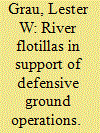| Srl | Item |
| 1 |
ID:
148388


|
|
|
|
|
| Summary/Abstract |
In the history of warfare, ground and naval forces frequently have to cooperate. There are usually problems putting these two forces together since their missions, equipment, training, communications and mutual unfamiliarity get in the way. These problems are common during transport of ground force equipment and personnel aboard naval vessels, exacerbated during amphibious landings and assaults and very difficult when operating together along major rivers. This article analyzes the Soviet history of defensive river flotilla combat during the first period of the Great Patriotic War (World War II against Germany). It outlines missions, the operational environment, lessons learned, the command and control problems experienced between naval and ground forces and the challenges of conducting such operations.
|
|
|
|
|
|
|
|
|
|
|
|
|
|
|
|
| 2 |
ID:
170489


|
|
|
|
|
| Summary/Abstract |
Large rivers and lakes have served as major arteries of industry and commerce, defensive barriers, lines of communication, and avenues of advance. These bodies of water have been and are prime factors in European warfare. Armies are more accustomed to solving the problem of crossing rivers rather than controlling stretches or the entirety of the river or lake. Yet control of the river or lake can be more decisive to a campaign than a crossing. Large rivers rise also to the level of a naval problem. Armies should interact closely with brown-water or green-water navies as they attempt to control the important inland waterways. There are almost no contemporary studies that illuminate this important operational environment in the European theater. However, the Soviet experience in WWII does offer a rich examination and one that offers lessons for consideration today. This study examines the interactions of the Soviet Dniepr River Flotilla and Red Army during Operation Bagration in World War II and draws applicable lessons for the present. The lessons of this campaign are still studied in Russian military academies and colleges and are applied in active training today.
|
|
|
|
|
|
|
|
|
|
|
|
|
|
|
|